Financial Accounting: Statement Analysis & Ratios Homework
VerifiedAdded on 2023/06/15
|13
|3793
|348
Homework Assignment
AI Summary
This accounting assignment solution includes the preparation of an income statement and balance sheet, along with a discussion on the usefulness of financial statements for decision-making, referencing faithful representation and relevance. It also involves calculating financial ratios for 2019 and 2020, analyzing the company's profitability, liquidity, and financial risk based on these ratios. The analysis covers key metrics such as gross profit margin, operating profit margin, return on capital employed, asset turnover, quick ratio, working capital cycle, cash conversion rate, and gearing ratio. The solution also provides detailed working notes for the calculations and discusses assumptions that can be made based on the financial statements, offering a comprehensive overview of the company's financial health and performance.
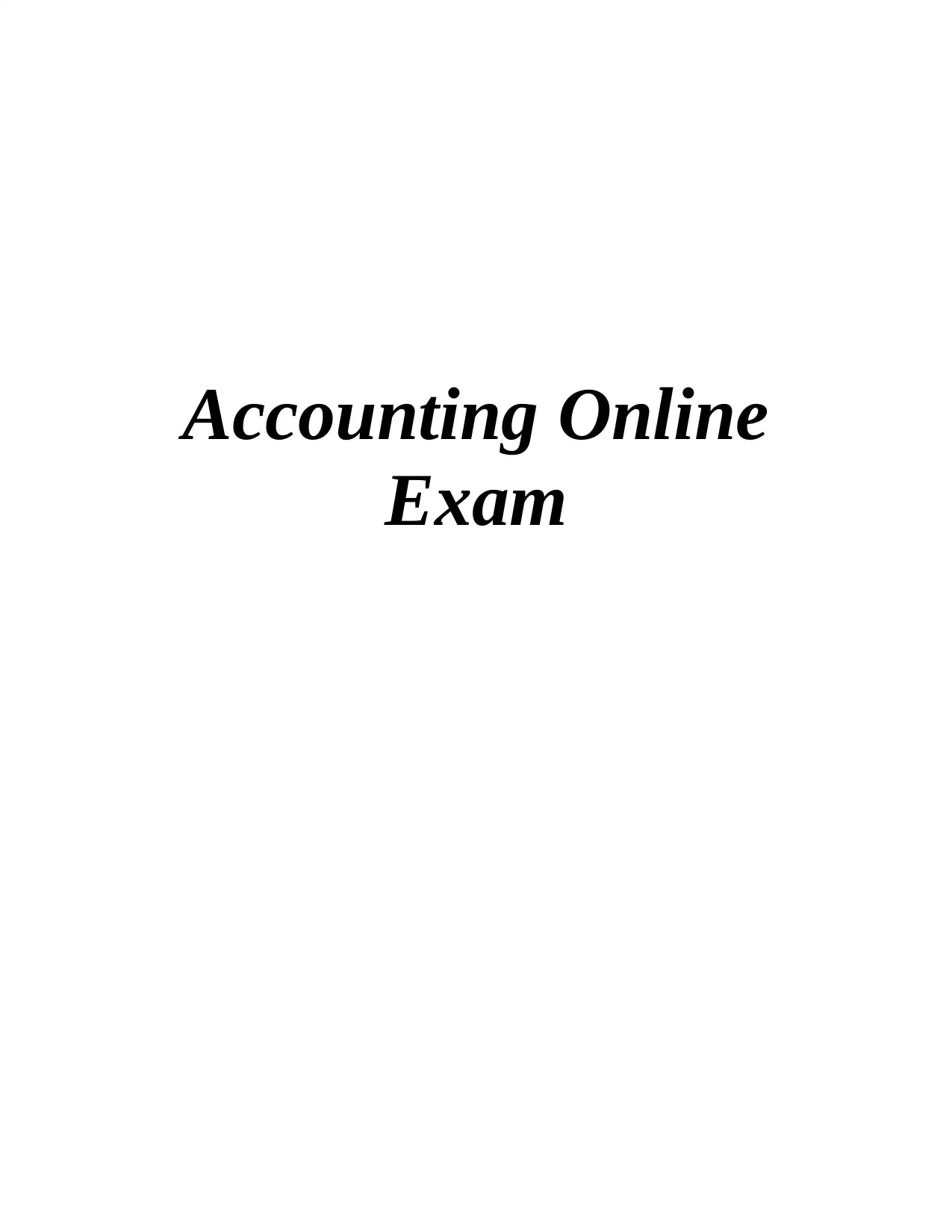
Accounting Online
Exam
Exam
Paraphrase This Document
Need a fresh take? Get an instant paraphrase of this document with our AI Paraphraser
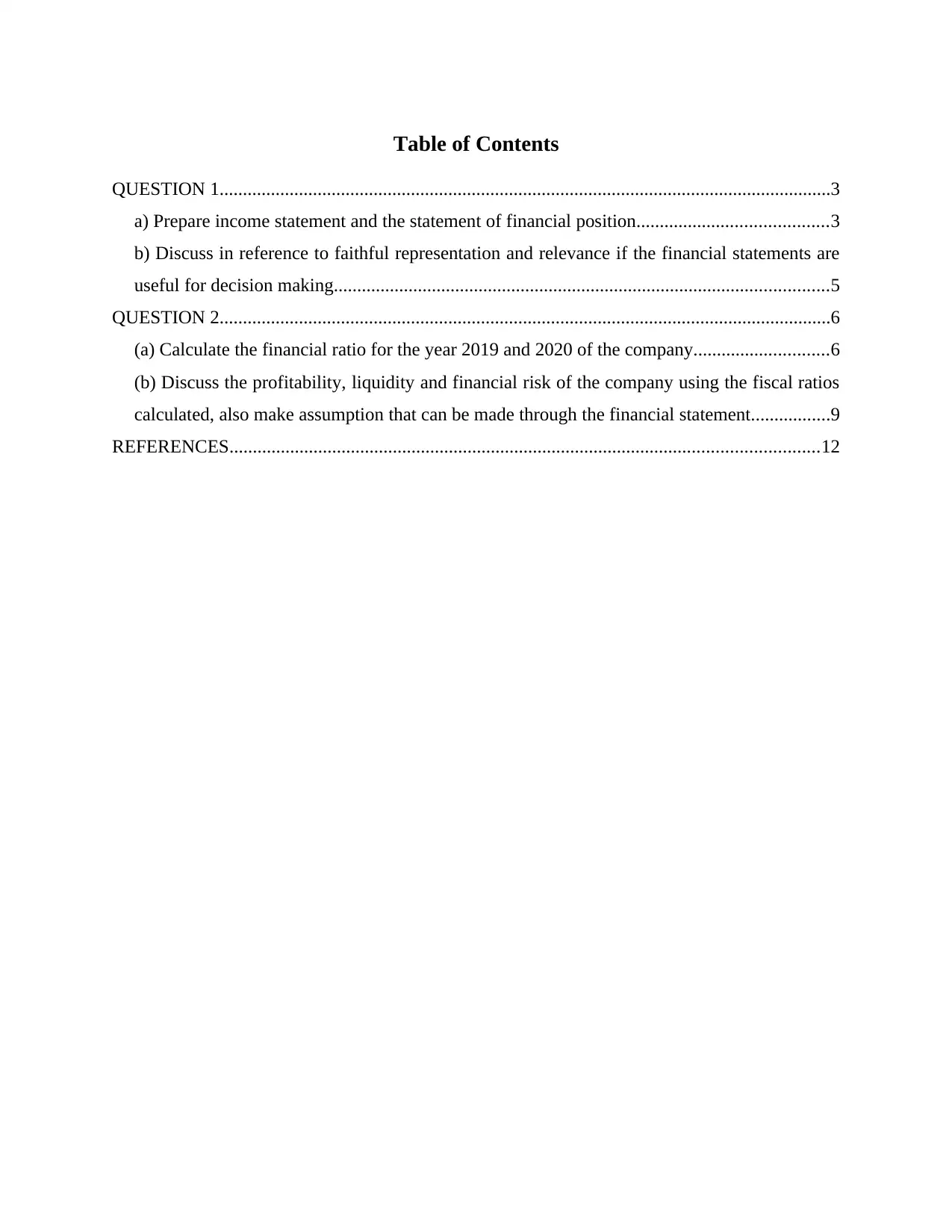
Table of Contents
QUESTION 1...................................................................................................................................3
a) Prepare income statement and the statement of financial position.........................................3
b) Discuss in reference to faithful representation and relevance if the financial statements are
useful for decision making..........................................................................................................5
QUESTION 2...................................................................................................................................6
(a) Calculate the financial ratio for the year 2019 and 2020 of the company.............................6
(b) Discuss the profitability, liquidity and financial risk of the company using the fiscal ratios
calculated, also make assumption that can be made through the financial statement.................9
REFERENCES..............................................................................................................................12
QUESTION 1...................................................................................................................................3
a) Prepare income statement and the statement of financial position.........................................3
b) Discuss in reference to faithful representation and relevance if the financial statements are
useful for decision making..........................................................................................................5
QUESTION 2...................................................................................................................................6
(a) Calculate the financial ratio for the year 2019 and 2020 of the company.............................6
(b) Discuss the profitability, liquidity and financial risk of the company using the fiscal ratios
calculated, also make assumption that can be made through the financial statement.................9
REFERENCES..............................................................................................................................12
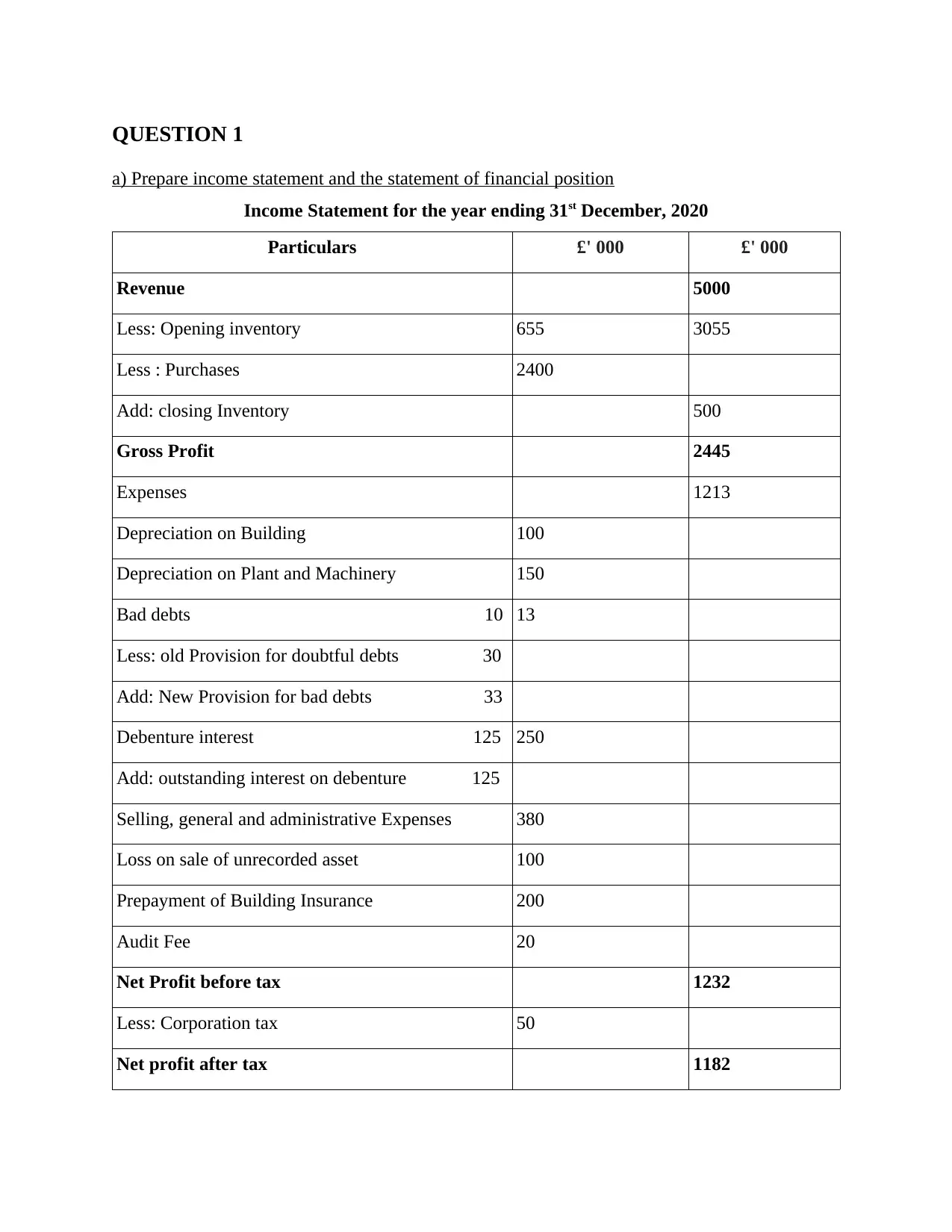
QUESTION 1
a) Prepare income statement and the statement of financial position
Income Statement for the year ending 31st December, 2020
Particulars £' 000 £' 000
Revenue 5000
Less: Opening inventory 655 3055
Less : Purchases 2400
Add: closing Inventory 500
Gross Profit 2445
Expenses 1213
Depreciation on Building 100
Depreciation on Plant and Machinery 150
Bad debts 10 13
Less: old Provision for doubtful debts 30
Add: New Provision for bad debts 33
Debenture interest 125 250
Add: outstanding interest on debenture 125
Selling, general and administrative Expenses 380
Loss on sale of unrecorded asset 100
Prepayment of Building Insurance 200
Audit Fee 20
Net Profit before tax 1232
Less: Corporation tax 50
Net profit after tax 1182
a) Prepare income statement and the statement of financial position
Income Statement for the year ending 31st December, 2020
Particulars £' 000 £' 000
Revenue 5000
Less: Opening inventory 655 3055
Less : Purchases 2400
Add: closing Inventory 500
Gross Profit 2445
Expenses 1213
Depreciation on Building 100
Depreciation on Plant and Machinery 150
Bad debts 10 13
Less: old Provision for doubtful debts 30
Add: New Provision for bad debts 33
Debenture interest 125 250
Add: outstanding interest on debenture 125
Selling, general and administrative Expenses 380
Loss on sale of unrecorded asset 100
Prepayment of Building Insurance 200
Audit Fee 20
Net Profit before tax 1232
Less: Corporation tax 50
Net profit after tax 1182
⊘ This is a preview!⊘
Do you want full access?
Subscribe today to unlock all pages.

Trusted by 1+ million students worldwide
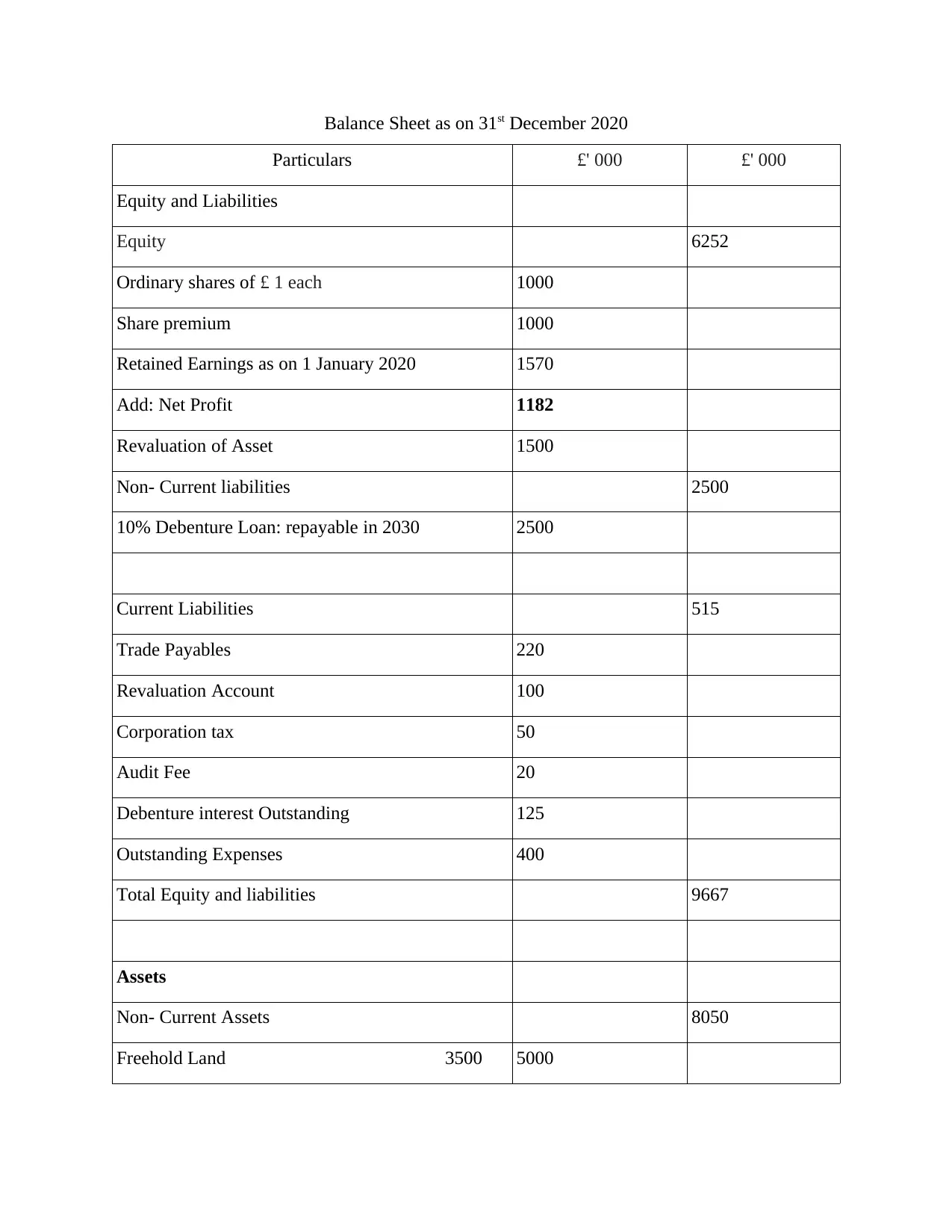
Balance Sheet as on 31st December 2020
Particulars £' 000 £' 000
Equity and Liabilities
Equity 6252
Ordinary shares of £ 1 each 1000
Share premium 1000
Retained Earnings as on 1 January 2020 1570
Add: Net Profit 1182
Revaluation of Asset 1500
Non- Current liabilities 2500
10% Debenture Loan: repayable in 2030 2500
Current Liabilities 515
Trade Payables 220
Revaluation Account 100
Corporation tax 50
Audit Fee 20
Debenture interest Outstanding 125
Outstanding Expenses 400
Total Equity and liabilities 9667
Assets
Non- Current Assets 8050
Freehold Land 3500 5000
Particulars £' 000 £' 000
Equity and Liabilities
Equity 6252
Ordinary shares of £ 1 each 1000
Share premium 1000
Retained Earnings as on 1 January 2020 1570
Add: Net Profit 1182
Revaluation of Asset 1500
Non- Current liabilities 2500
10% Debenture Loan: repayable in 2030 2500
Current Liabilities 515
Trade Payables 220
Revaluation Account 100
Corporation tax 50
Audit Fee 20
Debenture interest Outstanding 125
Outstanding Expenses 400
Total Equity and liabilities 9667
Assets
Non- Current Assets 8050
Freehold Land 3500 5000
Paraphrase This Document
Need a fresh take? Get an instant paraphrase of this document with our AI Paraphraser
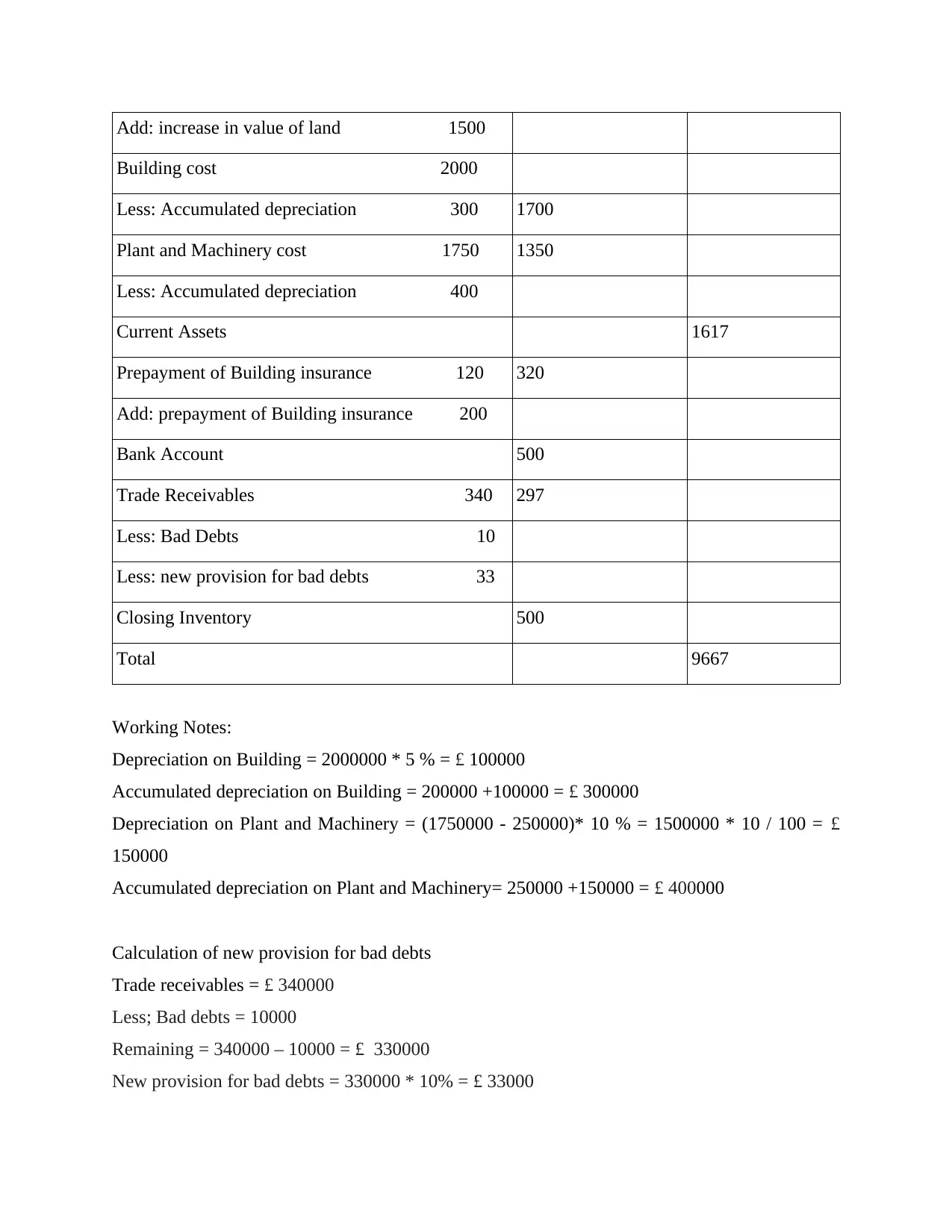
Add: increase in value of land 1500
Building cost 2000
Less: Accumulated depreciation 300 1700
Plant and Machinery cost 1750 1350
Less: Accumulated depreciation 400
Current Assets 1617
Prepayment of Building insurance 120 320
Add: prepayment of Building insurance 200
Bank Account 500
Trade Receivables 340 297
Less: Bad Debts 10
Less: new provision for bad debts 33
Closing Inventory 500
Total 9667
Working Notes:
Depreciation on Building = 2000000 * 5 % = £ 100000
Accumulated depreciation on Building = 200000 +100000 = £ 300000
Depreciation on Plant and Machinery = (1750000 - 250000)* 10 % = 1500000 * 10 / 100 = £
150000
Accumulated depreciation on Plant and Machinery= 250000 +150000 = £ 400000
Calculation of new provision for bad debts
Trade receivables = £ 340000
Less; Bad debts = 10000
Remaining = 340000 – 10000 = £ 330000
New provision for bad debts = 330000 * 10% = £ 33000
Building cost 2000
Less: Accumulated depreciation 300 1700
Plant and Machinery cost 1750 1350
Less: Accumulated depreciation 400
Current Assets 1617
Prepayment of Building insurance 120 320
Add: prepayment of Building insurance 200
Bank Account 500
Trade Receivables 340 297
Less: Bad Debts 10
Less: new provision for bad debts 33
Closing Inventory 500
Total 9667
Working Notes:
Depreciation on Building = 2000000 * 5 % = £ 100000
Accumulated depreciation on Building = 200000 +100000 = £ 300000
Depreciation on Plant and Machinery = (1750000 - 250000)* 10 % = 1500000 * 10 / 100 = £
150000
Accumulated depreciation on Plant and Machinery= 250000 +150000 = £ 400000
Calculation of new provision for bad debts
Trade receivables = £ 340000
Less; Bad debts = 10000
Remaining = 340000 – 10000 = £ 330000
New provision for bad debts = 330000 * 10% = £ 33000

Calculation of debenture interest
Debenture = £ 2500000
Annual interest = 2500000 * 10% = £ 250000
Already paid interest = £ 125000
Interest Outstanding = 250000 – 125000 = £ 125000
b) Discuss in reference to faithful representation and relevance if the financial statements are
useful for decision making.
Financial statements are the summarised record of all the financial actions undertaken or
to be undertaken by the firm. It provides information about the expenses, incomes, liabilities and
assets hold by business. Mostly these reports are made in accordance to the historical value of
the item but sometimes their values are also revalued according to their market value. Normally,
the financial statements provide accurate information about the company and are reliable. But
this factor also depends on the person preparing the accounts. If the accountant omits some entry
or tries to commit fraud or any misrepresentation then , the balances of balance sheet being equal
can present wrong information. Also there are some kinds of hidden errors that cannot be
identified easily. Even these mistakes are not captured through trial balances. In such case, the
knowledge provided by these reports can not be regarded as trustworthy for making decisions. A
wrong prepared report can negatively impact the decision making process of the company.
A faithful financial statement is one which is free from any kind of error, comprises of all
kinds of information and is neutral from all aspects. For this, it is important to regularly reconcile
the financial statements and the accounting records.
Financial statements do not help in making predictions as it is prepared on the historic
values. But it can be used for predicting the future. They act as a base on which the forecasters
anticipate the future. They conduct analysis on these statements for ascertaining the position of
firm. These reports helps the analyst in checking out the trend followed by companies profits and
expenses in past time and impact of the external environment on these reports. Through this they
examine the coming circumstances and make predictions for the firm in respect to these
statements. But for making forecast in correct manner, it is important that the records are updated
Debenture = £ 2500000
Annual interest = 2500000 * 10% = £ 250000
Already paid interest = £ 125000
Interest Outstanding = 250000 – 125000 = £ 125000
b) Discuss in reference to faithful representation and relevance if the financial statements are
useful for decision making.
Financial statements are the summarised record of all the financial actions undertaken or
to be undertaken by the firm. It provides information about the expenses, incomes, liabilities and
assets hold by business. Mostly these reports are made in accordance to the historical value of
the item but sometimes their values are also revalued according to their market value. Normally,
the financial statements provide accurate information about the company and are reliable. But
this factor also depends on the person preparing the accounts. If the accountant omits some entry
or tries to commit fraud or any misrepresentation then , the balances of balance sheet being equal
can present wrong information. Also there are some kinds of hidden errors that cannot be
identified easily. Even these mistakes are not captured through trial balances. In such case, the
knowledge provided by these reports can not be regarded as trustworthy for making decisions. A
wrong prepared report can negatively impact the decision making process of the company.
A faithful financial statement is one which is free from any kind of error, comprises of all
kinds of information and is neutral from all aspects. For this, it is important to regularly reconcile
the financial statements and the accounting records.
Financial statements do not help in making predictions as it is prepared on the historic
values. But it can be used for predicting the future. They act as a base on which the forecasters
anticipate the future. They conduct analysis on these statements for ascertaining the position of
firm. These reports helps the analyst in checking out the trend followed by companies profits and
expenses in past time and impact of the external environment on these reports. Through this they
examine the coming circumstances and make predictions for the firm in respect to these
statements. But for making forecast in correct manner, it is important that the records are updated
⊘ This is a preview!⊘
Do you want full access?
Subscribe today to unlock all pages.

Trusted by 1+ million students worldwide
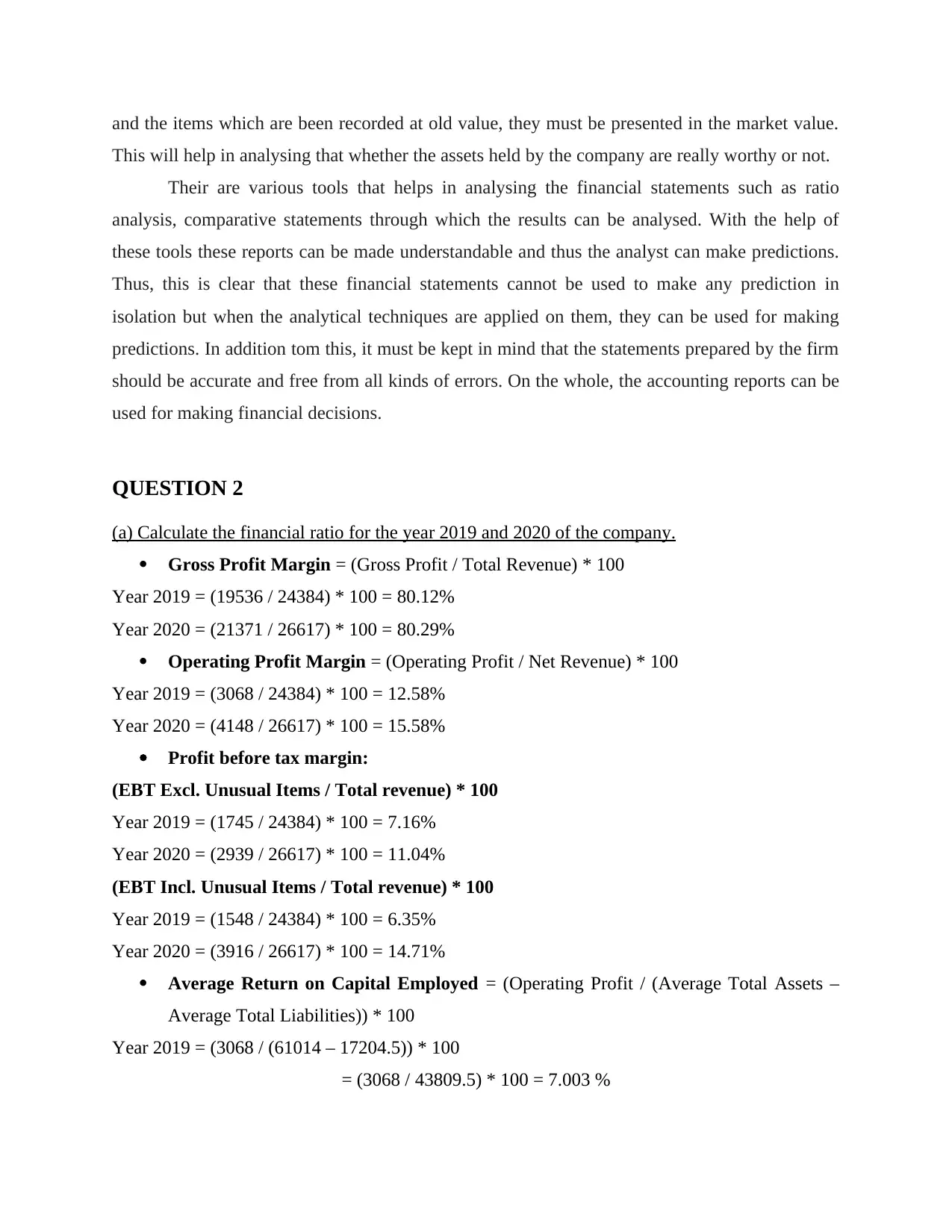
and the items which are been recorded at old value, they must be presented in the market value.
This will help in analysing that whether the assets held by the company are really worthy or not.
Their are various tools that helps in analysing the financial statements such as ratio
analysis, comparative statements through which the results can be analysed. With the help of
these tools these reports can be made understandable and thus the analyst can make predictions.
Thus, this is clear that these financial statements cannot be used to make any prediction in
isolation but when the analytical techniques are applied on them, they can be used for making
predictions. In addition tom this, it must be kept in mind that the statements prepared by the firm
should be accurate and free from all kinds of errors. On the whole, the accounting reports can be
used for making financial decisions.
QUESTION 2
(a) Calculate the financial ratio for the year 2019 and 2020 of the company.
Gross Profit Margin = (Gross Profit / Total Revenue) * 100
Year 2019 = (19536 / 24384) * 100 = 80.12%
Year 2020 = (21371 / 26617) * 100 = 80.29%
Operating Profit Margin = (Operating Profit / Net Revenue) * 100
Year 2019 = (3068 / 24384) * 100 = 12.58%
Year 2020 = (4148 / 26617) * 100 = 15.58%
Profit before tax margin:
(EBT Excl. Unusual Items / Total revenue) * 100
Year 2019 = (1745 / 24384) * 100 = 7.16%
Year 2020 = (2939 / 26617) * 100 = 11.04%
(EBT Incl. Unusual Items / Total revenue) * 100
Year 2019 = (1548 / 24384) * 100 = 6.35%
Year 2020 = (3916 / 26617) * 100 = 14.71%
Average Return on Capital Employed = (Operating Profit / (Average Total Assets –
Average Total Liabilities)) * 100
Year 2019 = (3068 / (61014 – 17204.5)) * 100
= (3068 / 43809.5) * 100 = 7.003 %
This will help in analysing that whether the assets held by the company are really worthy or not.
Their are various tools that helps in analysing the financial statements such as ratio
analysis, comparative statements through which the results can be analysed. With the help of
these tools these reports can be made understandable and thus the analyst can make predictions.
Thus, this is clear that these financial statements cannot be used to make any prediction in
isolation but when the analytical techniques are applied on them, they can be used for making
predictions. In addition tom this, it must be kept in mind that the statements prepared by the firm
should be accurate and free from all kinds of errors. On the whole, the accounting reports can be
used for making financial decisions.
QUESTION 2
(a) Calculate the financial ratio for the year 2019 and 2020 of the company.
Gross Profit Margin = (Gross Profit / Total Revenue) * 100
Year 2019 = (19536 / 24384) * 100 = 80.12%
Year 2020 = (21371 / 26617) * 100 = 80.29%
Operating Profit Margin = (Operating Profit / Net Revenue) * 100
Year 2019 = (3068 / 24384) * 100 = 12.58%
Year 2020 = (4148 / 26617) * 100 = 15.58%
Profit before tax margin:
(EBT Excl. Unusual Items / Total revenue) * 100
Year 2019 = (1745 / 24384) * 100 = 7.16%
Year 2020 = (2939 / 26617) * 100 = 11.04%
(EBT Incl. Unusual Items / Total revenue) * 100
Year 2019 = (1548 / 24384) * 100 = 6.35%
Year 2020 = (3916 / 26617) * 100 = 14.71%
Average Return on Capital Employed = (Operating Profit / (Average Total Assets –
Average Total Liabilities)) * 100
Year 2019 = (3068 / (61014 – 17204.5)) * 100
= (3068 / 43809.5) * 100 = 7.003 %
Paraphrase This Document
Need a fresh take? Get an instant paraphrase of this document with our AI Paraphraser
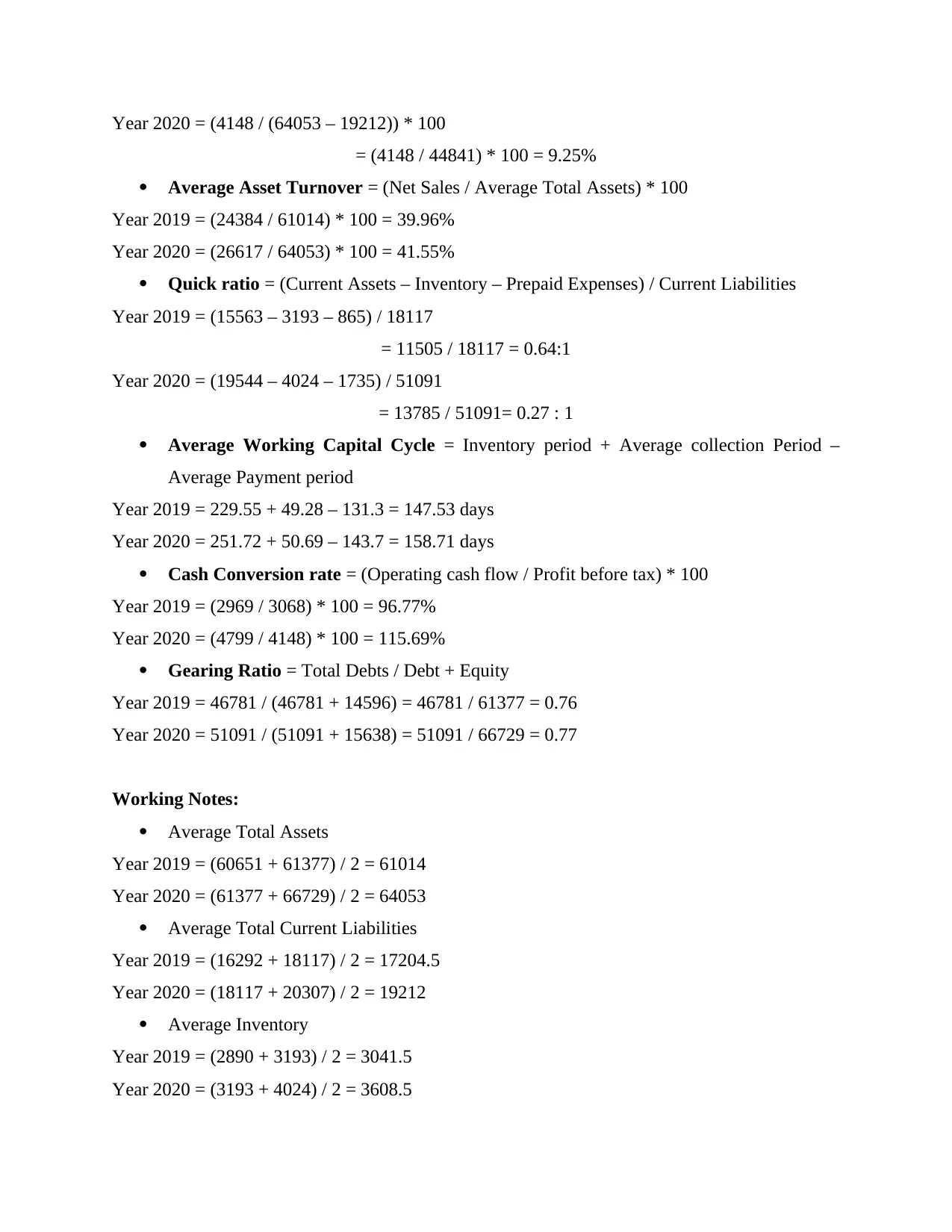
Year 2020 = (4148 / (64053 – 19212)) * 100
= (4148 / 44841) * 100 = 9.25%
Average Asset Turnover = (Net Sales / Average Total Assets) * 100
Year 2019 = (24384 / 61014) * 100 = 39.96%
Year 2020 = (26617 / 64053) * 100 = 41.55%
Quick ratio = (Current Assets – Inventory – Prepaid Expenses) / Current Liabilities
Year 2019 = (15563 – 3193 – 865) / 18117
= 11505 / 18117 = 0.64:1
Year 2020 = (19544 – 4024 – 1735) / 51091
= 13785 / 51091= 0.27 : 1
Average Working Capital Cycle = Inventory period + Average collection Period –
Average Payment period
Year 2019 = 229.55 + 49.28 – 131.3 = 147.53 days
Year 2020 = 251.72 + 50.69 – 143.7 = 158.71 days
Cash Conversion rate = (Operating cash flow / Profit before tax) * 100
Year 2019 = (2969 / 3068) * 100 = 96.77%
Year 2020 = (4799 / 4148) * 100 = 115.69%
Gearing Ratio = Total Debts / Debt + Equity
Year 2019 = 46781 / (46781 + 14596) = 46781 / 61377 = 0.76
Year 2020 = 51091 / (51091 + 15638) = 51091 / 66729 = 0.77
Working Notes:
Average Total Assets
Year 2019 = (60651 + 61377) / 2 = 61014
Year 2020 = (61377 + 66729) / 2 = 64053
Average Total Current Liabilities
Year 2019 = (16292 + 18117) / 2 = 17204.5
Year 2020 = (18117 + 20307) / 2 = 19212
Average Inventory
Year 2019 = (2890 + 3193) / 2 = 3041.5
Year 2020 = (3193 + 4024) / 2 = 3608.5
= (4148 / 44841) * 100 = 9.25%
Average Asset Turnover = (Net Sales / Average Total Assets) * 100
Year 2019 = (24384 / 61014) * 100 = 39.96%
Year 2020 = (26617 / 64053) * 100 = 41.55%
Quick ratio = (Current Assets – Inventory – Prepaid Expenses) / Current Liabilities
Year 2019 = (15563 – 3193 – 865) / 18117
= 11505 / 18117 = 0.64:1
Year 2020 = (19544 – 4024 – 1735) / 51091
= 13785 / 51091= 0.27 : 1
Average Working Capital Cycle = Inventory period + Average collection Period –
Average Payment period
Year 2019 = 229.55 + 49.28 – 131.3 = 147.53 days
Year 2020 = 251.72 + 50.69 – 143.7 = 158.71 days
Cash Conversion rate = (Operating cash flow / Profit before tax) * 100
Year 2019 = (2969 / 3068) * 100 = 96.77%
Year 2020 = (4799 / 4148) * 100 = 115.69%
Gearing Ratio = Total Debts / Debt + Equity
Year 2019 = 46781 / (46781 + 14596) = 46781 / 61377 = 0.76
Year 2020 = 51091 / (51091 + 15638) = 51091 / 66729 = 0.77
Working Notes:
Average Total Assets
Year 2019 = (60651 + 61377) / 2 = 61014
Year 2020 = (61377 + 66729) / 2 = 64053
Average Total Current Liabilities
Year 2019 = (16292 + 18117) / 2 = 17204.5
Year 2020 = (18117 + 20307) / 2 = 19212
Average Inventory
Year 2019 = (2890 + 3193) / 2 = 3041.5
Year 2020 = (3193 + 4024) / 2 = 3608.5
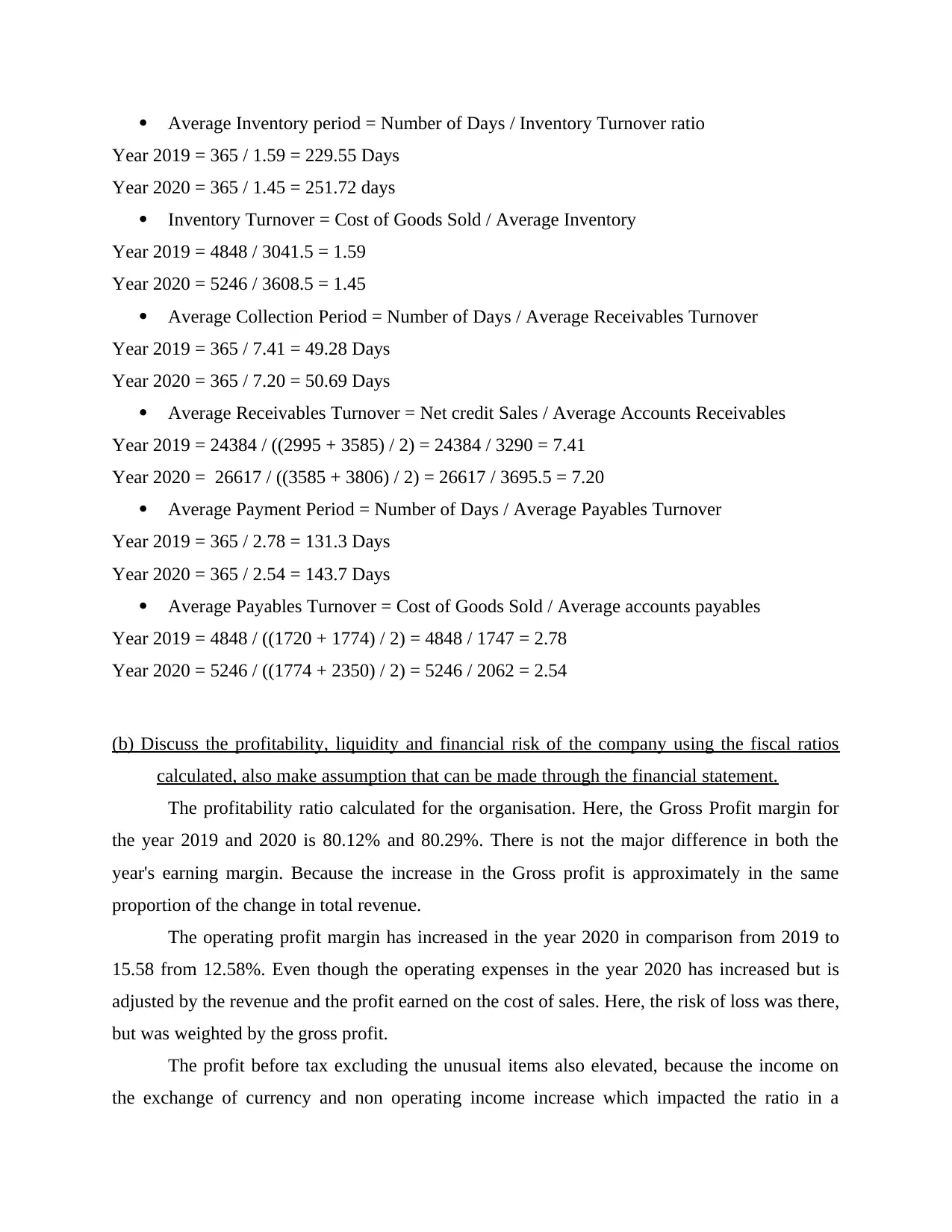
Average Inventory period = Number of Days / Inventory Turnover ratio
Year 2019 = 365 / 1.59 = 229.55 Days
Year 2020 = 365 / 1.45 = 251.72 days
Inventory Turnover = Cost of Goods Sold / Average Inventory
Year 2019 = 4848 / 3041.5 = 1.59
Year 2020 = 5246 / 3608.5 = 1.45
Average Collection Period = Number of Days / Average Receivables Turnover
Year 2019 = 365 / 7.41 = 49.28 Days
Year 2020 = 365 / 7.20 = 50.69 Days
Average Receivables Turnover = Net credit Sales / Average Accounts Receivables
Year 2019 = 24384 / ((2995 + 3585) / 2) = 24384 / 3290 = 7.41
Year 2020 = 26617 / ((3585 + 3806) / 2) = 26617 / 3695.5 = 7.20
Average Payment Period = Number of Days / Average Payables Turnover
Year 2019 = 365 / 2.78 = 131.3 Days
Year 2020 = 365 / 2.54 = 143.7 Days
Average Payables Turnover = Cost of Goods Sold / Average accounts payables
Year 2019 = 4848 / ((1720 + 1774) / 2) = 4848 / 1747 = 2.78
Year 2020 = 5246 / ((1774 + 2350) / 2) = 5246 / 2062 = 2.54
(b) Discuss the profitability, liquidity and financial risk of the company using the fiscal ratios
calculated, also make assumption that can be made through the financial statement.
The profitability ratio calculated for the organisation. Here, the Gross Profit margin for
the year 2019 and 2020 is 80.12% and 80.29%. There is not the major difference in both the
year's earning margin. Because the increase in the Gross profit is approximately in the same
proportion of the change in total revenue.
The operating profit margin has increased in the year 2020 in comparison from 2019 to
15.58 from 12.58%. Even though the operating expenses in the year 2020 has increased but is
adjusted by the revenue and the profit earned on the cost of sales. Here, the risk of loss was there,
but was weighted by the gross profit.
The profit before tax excluding the unusual items also elevated, because the income on
the exchange of currency and non operating income increase which impacted the ratio in a
Year 2019 = 365 / 1.59 = 229.55 Days
Year 2020 = 365 / 1.45 = 251.72 days
Inventory Turnover = Cost of Goods Sold / Average Inventory
Year 2019 = 4848 / 3041.5 = 1.59
Year 2020 = 5246 / 3608.5 = 1.45
Average Collection Period = Number of Days / Average Receivables Turnover
Year 2019 = 365 / 7.41 = 49.28 Days
Year 2020 = 365 / 7.20 = 50.69 Days
Average Receivables Turnover = Net credit Sales / Average Accounts Receivables
Year 2019 = 24384 / ((2995 + 3585) / 2) = 24384 / 3290 = 7.41
Year 2020 = 26617 / ((3585 + 3806) / 2) = 26617 / 3695.5 = 7.20
Average Payment Period = Number of Days / Average Payables Turnover
Year 2019 = 365 / 2.78 = 131.3 Days
Year 2020 = 365 / 2.54 = 143.7 Days
Average Payables Turnover = Cost of Goods Sold / Average accounts payables
Year 2019 = 4848 / ((1720 + 1774) / 2) = 4848 / 1747 = 2.78
Year 2020 = 5246 / ((1774 + 2350) / 2) = 5246 / 2062 = 2.54
(b) Discuss the profitability, liquidity and financial risk of the company using the fiscal ratios
calculated, also make assumption that can be made through the financial statement.
The profitability ratio calculated for the organisation. Here, the Gross Profit margin for
the year 2019 and 2020 is 80.12% and 80.29%. There is not the major difference in both the
year's earning margin. Because the increase in the Gross profit is approximately in the same
proportion of the change in total revenue.
The operating profit margin has increased in the year 2020 in comparison from 2019 to
15.58 from 12.58%. Even though the operating expenses in the year 2020 has increased but is
adjusted by the revenue and the profit earned on the cost of sales. Here, the risk of loss was there,
but was weighted by the gross profit.
The profit before tax excluding the unusual items also elevated, because the income on
the exchange of currency and non operating income increase which impacted the ratio in a
⊘ This is a preview!⊘
Do you want full access?
Subscribe today to unlock all pages.

Trusted by 1+ million students worldwide
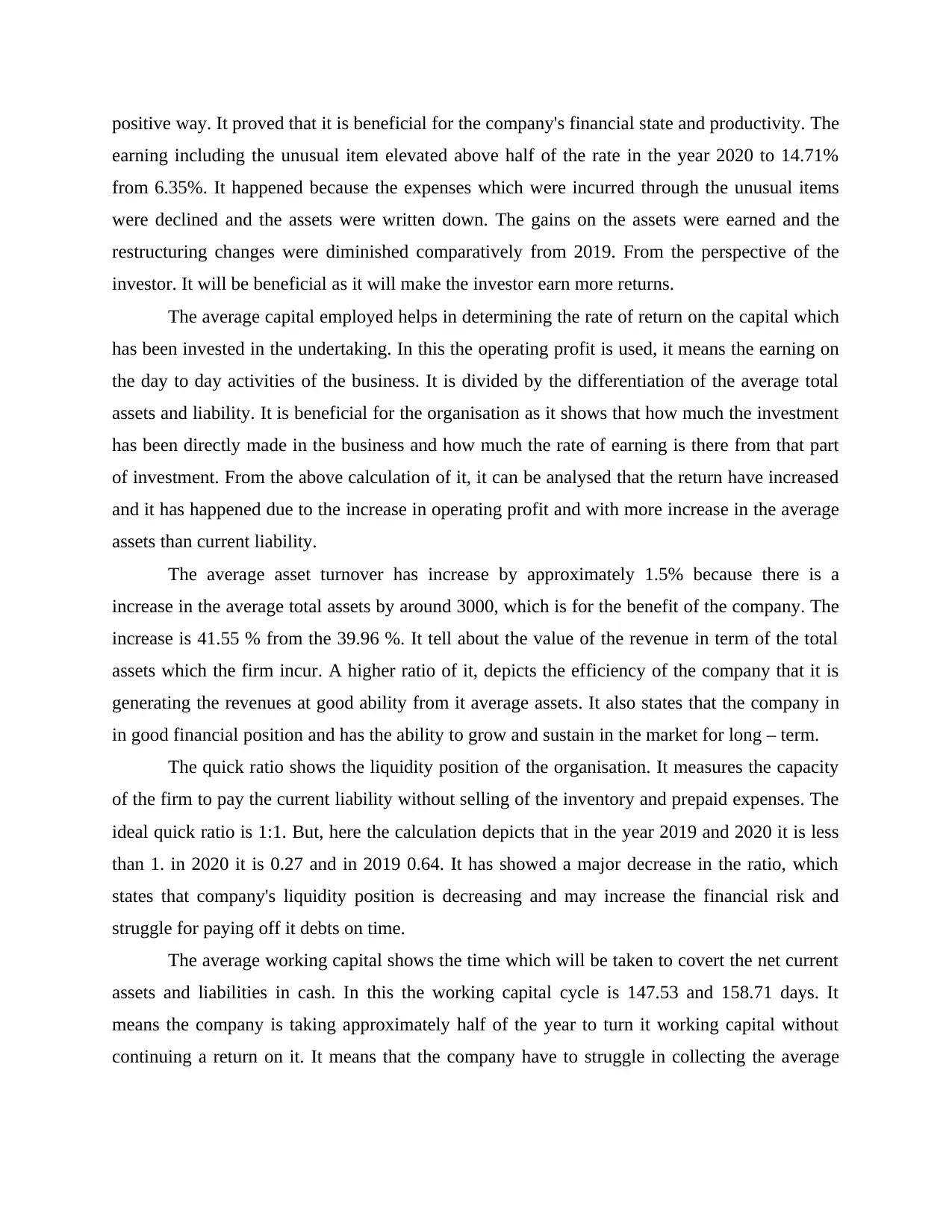
positive way. It proved that it is beneficial for the company's financial state and productivity. The
earning including the unusual item elevated above half of the rate in the year 2020 to 14.71%
from 6.35%. It happened because the expenses which were incurred through the unusual items
were declined and the assets were written down. The gains on the assets were earned and the
restructuring changes were diminished comparatively from 2019. From the perspective of the
investor. It will be beneficial as it will make the investor earn more returns.
The average capital employed helps in determining the rate of return on the capital which
has been invested in the undertaking. In this the operating profit is used, it means the earning on
the day to day activities of the business. It is divided by the differentiation of the average total
assets and liability. It is beneficial for the organisation as it shows that how much the investment
has been directly made in the business and how much the rate of earning is there from that part
of investment. From the above calculation of it, it can be analysed that the return have increased
and it has happened due to the increase in operating profit and with more increase in the average
assets than current liability.
The average asset turnover has increase by approximately 1.5% because there is a
increase in the average total assets by around 3000, which is for the benefit of the company. The
increase is 41.55 % from the 39.96 %. It tell about the value of the revenue in term of the total
assets which the firm incur. A higher ratio of it, depicts the efficiency of the company that it is
generating the revenues at good ability from it average assets. It also states that the company in
in good financial position and has the ability to grow and sustain in the market for long – term.
The quick ratio shows the liquidity position of the organisation. It measures the capacity
of the firm to pay the current liability without selling of the inventory and prepaid expenses. The
ideal quick ratio is 1:1. But, here the calculation depicts that in the year 2019 and 2020 it is less
than 1. in 2020 it is 0.27 and in 2019 0.64. It has showed a major decrease in the ratio, which
states that company's liquidity position is decreasing and may increase the financial risk and
struggle for paying off it debts on time.
The average working capital shows the time which will be taken to covert the net current
assets and liabilities in cash. In this the working capital cycle is 147.53 and 158.71 days. It
means the company is taking approximately half of the year to turn it working capital without
continuing a return on it. It means that the company have to struggle in collecting the average
earning including the unusual item elevated above half of the rate in the year 2020 to 14.71%
from 6.35%. It happened because the expenses which were incurred through the unusual items
were declined and the assets were written down. The gains on the assets were earned and the
restructuring changes were diminished comparatively from 2019. From the perspective of the
investor. It will be beneficial as it will make the investor earn more returns.
The average capital employed helps in determining the rate of return on the capital which
has been invested in the undertaking. In this the operating profit is used, it means the earning on
the day to day activities of the business. It is divided by the differentiation of the average total
assets and liability. It is beneficial for the organisation as it shows that how much the investment
has been directly made in the business and how much the rate of earning is there from that part
of investment. From the above calculation of it, it can be analysed that the return have increased
and it has happened due to the increase in operating profit and with more increase in the average
assets than current liability.
The average asset turnover has increase by approximately 1.5% because there is a
increase in the average total assets by around 3000, which is for the benefit of the company. The
increase is 41.55 % from the 39.96 %. It tell about the value of the revenue in term of the total
assets which the firm incur. A higher ratio of it, depicts the efficiency of the company that it is
generating the revenues at good ability from it average assets. It also states that the company in
in good financial position and has the ability to grow and sustain in the market for long – term.
The quick ratio shows the liquidity position of the organisation. It measures the capacity
of the firm to pay the current liability without selling of the inventory and prepaid expenses. The
ideal quick ratio is 1:1. But, here the calculation depicts that in the year 2019 and 2020 it is less
than 1. in 2020 it is 0.27 and in 2019 0.64. It has showed a major decrease in the ratio, which
states that company's liquidity position is decreasing and may increase the financial risk and
struggle for paying off it debts on time.
The average working capital shows the time which will be taken to covert the net current
assets and liabilities in cash. In this the working capital cycle is 147.53 and 158.71 days. It
means the company is taking approximately half of the year to turn it working capital without
continuing a return on it. It means that the company have to struggle in collecting the average
Paraphrase This Document
Need a fresh take? Get an instant paraphrase of this document with our AI Paraphraser

receivable on time from their debtors with stretching the payment which has to be done to their
creditors.
The cash conversion rate shows he relationship between the operating cash flow and the
profit which has been earning by the company before paying the tax and interest. It shows the
ability of the firm that how much profit it can convert into cash. In 2019, the ratio was 96.77
which was below 100. But in the year 2020, it is more than 100 which is 115.69%. It means that
the company has the ability to convert a high amount of earnings into cash. It will thereby
increase the liquidity position and the financial state of the organisation.
The gearing ratio depicts the financial risk which is associated with the firm. If the
company has more debt, it means that it is borrowing more from the market has low efficiency to
manage it expenses from the internal funds. A low gearing ratio will be beneficial for the firm.
Assumptions:
In quick ratio, it is assumed that the debtors can be converted into cash in the short term
and prepaid expenses.
In this, the calculation are performed on the basis of the given financial statement. So it is
assumed that the data provided is accurate without any error.
The techniques of calculating the formula can be different of numerous companies on the
basis of their assumptions taken. For example, in debt only long – term debts can be
taken or whole liabilities can also be taken. It depends on the companies functionality.
The revenue of the business is growing continuously for the last two years. It decreased to some
extent in 2018 but regained it growth after that. The same growth can be seen in cost of goods
sold. But in year 2018, when the sales of the firm was decreasing the cost of goods sold
increased constantly which affected the gross profit. After 2018, this amount of business is also
increasing. Firm is continuously investing in selling and administration expenses but with
different rate. The rise in this value was more in 2018 and 2019 as compared to 2020. The
operating profit of business is not showing much returns when looking the sales of 2017 and
2020. The sales of firm in the two years are showing grate difference but this cannot be viewed
in operating profits of business. The interest payment of business is also growing but the income
in respect to this reduced in year 2020, though the long term investment of the firm increased. It
can be due to decrease in short term investment holdings of business. The Earning of business
creditors.
The cash conversion rate shows he relationship between the operating cash flow and the
profit which has been earning by the company before paying the tax and interest. It shows the
ability of the firm that how much profit it can convert into cash. In 2019, the ratio was 96.77
which was below 100. But in the year 2020, it is more than 100 which is 115.69%. It means that
the company has the ability to convert a high amount of earnings into cash. It will thereby
increase the liquidity position and the financial state of the organisation.
The gearing ratio depicts the financial risk which is associated with the firm. If the
company has more debt, it means that it is borrowing more from the market has low efficiency to
manage it expenses from the internal funds. A low gearing ratio will be beneficial for the firm.
Assumptions:
In quick ratio, it is assumed that the debtors can be converted into cash in the short term
and prepaid expenses.
In this, the calculation are performed on the basis of the given financial statement. So it is
assumed that the data provided is accurate without any error.
The techniques of calculating the formula can be different of numerous companies on the
basis of their assumptions taken. For example, in debt only long – term debts can be
taken or whole liabilities can also be taken. It depends on the companies functionality.
The revenue of the business is growing continuously for the last two years. It decreased to some
extent in 2018 but regained it growth after that. The same growth can be seen in cost of goods
sold. But in year 2018, when the sales of the firm was decreasing the cost of goods sold
increased constantly which affected the gross profit. After 2018, this amount of business is also
increasing. Firm is continuously investing in selling and administration expenses but with
different rate. The rise in this value was more in 2018 and 2019 as compared to 2020. The
operating profit of business is not showing much returns when looking the sales of 2017 and
2020. The sales of firm in the two years are showing grate difference but this cannot be viewed
in operating profits of business. The interest payment of business is also growing but the income
in respect to this reduced in year 2020, though the long term investment of the firm increased. It
can be due to decrease in short term investment holdings of business. The Earning of business
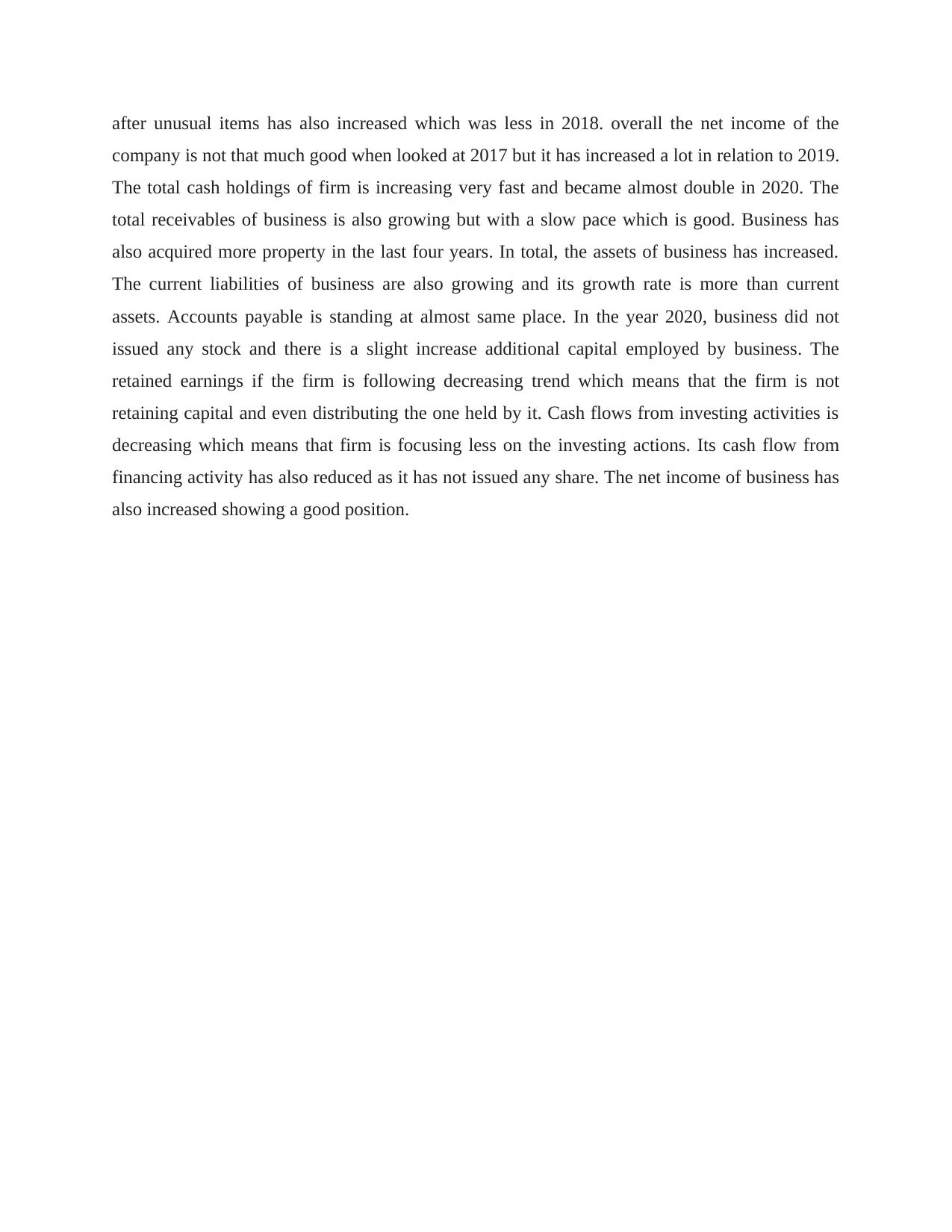
after unusual items has also increased which was less in 2018. overall the net income of the
company is not that much good when looked at 2017 but it has increased a lot in relation to 2019.
The total cash holdings of firm is increasing very fast and became almost double in 2020. The
total receivables of business is also growing but with a slow pace which is good. Business has
also acquired more property in the last four years. In total, the assets of business has increased.
The current liabilities of business are also growing and its growth rate is more than current
assets. Accounts payable is standing at almost same place. In the year 2020, business did not
issued any stock and there is a slight increase additional capital employed by business. The
retained earnings if the firm is following decreasing trend which means that the firm is not
retaining capital and even distributing the one held by it. Cash flows from investing activities is
decreasing which means that firm is focusing less on the investing actions. Its cash flow from
financing activity has also reduced as it has not issued any share. The net income of business has
also increased showing a good position.
company is not that much good when looked at 2017 but it has increased a lot in relation to 2019.
The total cash holdings of firm is increasing very fast and became almost double in 2020. The
total receivables of business is also growing but with a slow pace which is good. Business has
also acquired more property in the last four years. In total, the assets of business has increased.
The current liabilities of business are also growing and its growth rate is more than current
assets. Accounts payable is standing at almost same place. In the year 2020, business did not
issued any stock and there is a slight increase additional capital employed by business. The
retained earnings if the firm is following decreasing trend which means that the firm is not
retaining capital and even distributing the one held by it. Cash flows from investing activities is
decreasing which means that firm is focusing less on the investing actions. Its cash flow from
financing activity has also reduced as it has not issued any share. The net income of business has
also increased showing a good position.
⊘ This is a preview!⊘
Do you want full access?
Subscribe today to unlock all pages.

Trusted by 1+ million students worldwide
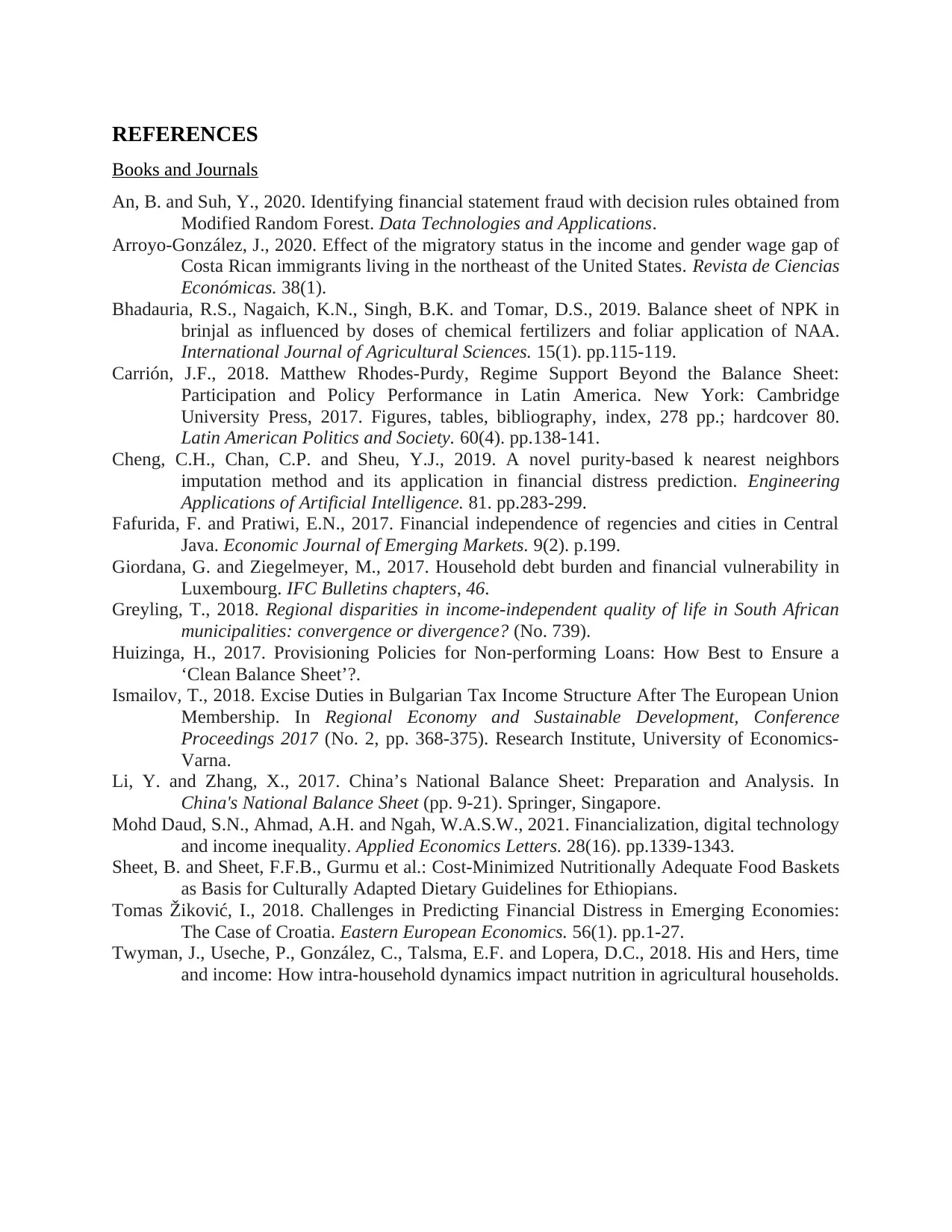
REFERENCES
Books and Journals
An, B. and Suh, Y., 2020. Identifying financial statement fraud with decision rules obtained from
Modified Random Forest. Data Technologies and Applications.
Arroyo-González, J., 2020. Effect of the migratory status in the income and gender wage gap of
Costa Rican immigrants living in the northeast of the United States. Revista de Ciencias
Económicas. 38(1).
Bhadauria, R.S., Nagaich, K.N., Singh, B.K. and Tomar, D.S., 2019. Balance sheet of NPK in
brinjal as influenced by doses of chemical fertilizers and foliar application of NAA.
International Journal of Agricultural Sciences. 15(1). pp.115-119.
Carrión, J.F., 2018. Matthew Rhodes-Purdy, Regime Support Beyond the Balance Sheet:
Participation and Policy Performance in Latin America. New York: Cambridge
University Press, 2017. Figures, tables, bibliography, index, 278 pp.; hardcover 80.
Latin American Politics and Society. 60(4). pp.138-141.
Cheng, C.H., Chan, C.P. and Sheu, Y.J., 2019. A novel purity-based k nearest neighbors
imputation method and its application in financial distress prediction. Engineering
Applications of Artificial Intelligence. 81. pp.283-299.
Fafurida, F. and Pratiwi, E.N., 2017. Financial independence of regencies and cities in Central
Java. Economic Journal of Emerging Markets. 9(2). p.199.
Giordana, G. and Ziegelmeyer, M., 2017. Household debt burden and financial vulnerability in
Luxembourg. IFC Bulletins chapters, 46.
Greyling, T., 2018. Regional disparities in income-independent quality of life in South African
municipalities: convergence or divergence? (No. 739).
Huizinga, H., 2017. Provisioning Policies for Non-performing Loans: How Best to Ensure a
‘Clean Balance Sheet’?.
Ismailov, T., 2018. Excise Duties in Bulgarian Tax Income Structure After The European Union
Membership. In Regional Economy and Sustainable Development, Conference
Proceedings 2017 (No. 2, pp. 368-375). Research Institute, University of Economics-
Varna.
Li, Y. and Zhang, X., 2017. China’s National Balance Sheet: Preparation and Analysis. In
China's National Balance Sheet (pp. 9-21). Springer, Singapore.
Mohd Daud, S.N., Ahmad, A.H. and Ngah, W.A.S.W., 2021. Financialization, digital technology
and income inequality. Applied Economics Letters. 28(16). pp.1339-1343.
Sheet, B. and Sheet, F.F.B., Gurmu et al.: Cost-Minimized Nutritionally Adequate Food Baskets
as Basis for Culturally Adapted Dietary Guidelines for Ethiopians.
Tomas Žiković, I., 2018. Challenges in Predicting Financial Distress in Emerging Economies:
The Case of Croatia. Eastern European Economics. 56(1). pp.1-27.
Twyman, J., Useche, P., González, C., Talsma, E.F. and Lopera, D.C., 2018. His and Hers, time
and income: How intra-household dynamics impact nutrition in agricultural households.
Books and Journals
An, B. and Suh, Y., 2020. Identifying financial statement fraud with decision rules obtained from
Modified Random Forest. Data Technologies and Applications.
Arroyo-González, J., 2020. Effect of the migratory status in the income and gender wage gap of
Costa Rican immigrants living in the northeast of the United States. Revista de Ciencias
Económicas. 38(1).
Bhadauria, R.S., Nagaich, K.N., Singh, B.K. and Tomar, D.S., 2019. Balance sheet of NPK in
brinjal as influenced by doses of chemical fertilizers and foliar application of NAA.
International Journal of Agricultural Sciences. 15(1). pp.115-119.
Carrión, J.F., 2018. Matthew Rhodes-Purdy, Regime Support Beyond the Balance Sheet:
Participation and Policy Performance in Latin America. New York: Cambridge
University Press, 2017. Figures, tables, bibliography, index, 278 pp.; hardcover 80.
Latin American Politics and Society. 60(4). pp.138-141.
Cheng, C.H., Chan, C.P. and Sheu, Y.J., 2019. A novel purity-based k nearest neighbors
imputation method and its application in financial distress prediction. Engineering
Applications of Artificial Intelligence. 81. pp.283-299.
Fafurida, F. and Pratiwi, E.N., 2017. Financial independence of regencies and cities in Central
Java. Economic Journal of Emerging Markets. 9(2). p.199.
Giordana, G. and Ziegelmeyer, M., 2017. Household debt burden and financial vulnerability in
Luxembourg. IFC Bulletins chapters, 46.
Greyling, T., 2018. Regional disparities in income-independent quality of life in South African
municipalities: convergence or divergence? (No. 739).
Huizinga, H., 2017. Provisioning Policies for Non-performing Loans: How Best to Ensure a
‘Clean Balance Sheet’?.
Ismailov, T., 2018. Excise Duties in Bulgarian Tax Income Structure After The European Union
Membership. In Regional Economy and Sustainable Development, Conference
Proceedings 2017 (No. 2, pp. 368-375). Research Institute, University of Economics-
Varna.
Li, Y. and Zhang, X., 2017. China’s National Balance Sheet: Preparation and Analysis. In
China's National Balance Sheet (pp. 9-21). Springer, Singapore.
Mohd Daud, S.N., Ahmad, A.H. and Ngah, W.A.S.W., 2021. Financialization, digital technology
and income inequality. Applied Economics Letters. 28(16). pp.1339-1343.
Sheet, B. and Sheet, F.F.B., Gurmu et al.: Cost-Minimized Nutritionally Adequate Food Baskets
as Basis for Culturally Adapted Dietary Guidelines for Ethiopians.
Tomas Žiković, I., 2018. Challenges in Predicting Financial Distress in Emerging Economies:
The Case of Croatia. Eastern European Economics. 56(1). pp.1-27.
Twyman, J., Useche, P., González, C., Talsma, E.F. and Lopera, D.C., 2018. His and Hers, time
and income: How intra-household dynamics impact nutrition in agricultural households.
1 out of 13
Related Documents
Your All-in-One AI-Powered Toolkit for Academic Success.
+13062052269
info@desklib.com
Available 24*7 on WhatsApp / Email
![[object Object]](/_next/static/media/star-bottom.7253800d.svg)
Unlock your academic potential
© 2024 | Zucol Services PVT LTD | All rights reserved.




